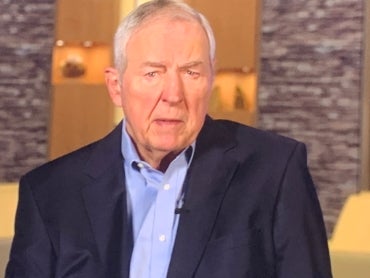Ad
 Microsoft CEO and chairman Satya Nadella. Image: Drew Robb/TechnologyAdvice
Microsoft CEO and chairman Satya Nadella. Image: Drew Robb/TechnologyAdvice
At the SAS Innovate conference I am attending in Orlando, Florida this week, there was a joint appearance by SAS CEO and cofounder Jim Goodnight and Microsoft CEO and chairman Satya Nadella, who discussed the future of artificial intelligence and its role in enterprise decision-making. The two tech leaders emphasized the need for responsible, AI-driven decisions that affect businesses, consumers, and society at large.
Goodnight said large language models (LLMs) that power generative AI (GenAI) are insufficient for advanced enterprise business analytics.
“GenAI does not replace everything in analytics, data science, and business intelligence,” he said. “In the enterprise, complex workflows need to be set up on the right decision-making framework.”
Nadella concurred.
“GenAI can be used to create a plan, but execution in the enterprise needs establishing of the right AI workflows,” said Nadella. “AI is changing how people work. Enormous progress has been made, but we have a long way to go.”
Nadella likened AI’s advancement in recent years to Moore’s Law — instead of compute power doubling every two years, it is the capabilities of AI models that are accelerating. The gains made in pre-training of models and testing of models are in hyperdrive, Nadella said. It is up to enterprise vendors and developers to parlay those capabilities into useful products.
Reflecting on what GenAI was achieving over the past 18 months, Nadella noted that, while early applications focused on basic code generation, emails, and query responses, current capabilities allow AI assistants to assign tasks to colleagues and manage workflows.
“AI is changing how I work and the work artifacts that I use,” said Nadella. “AI has reduced the time needed for some workloads from eight hours to 30 minutes.”
SEE: SAS Innovate Keynote: SAS Says ‘Goodbye, GenAI; Hello, Agentic AI’
SAS Decision Builder on Microsoft Fabric
SAS and Microsoft have been working together for five years; Goodnight showcased their collaboration on SAS Decision Builder and SAS Viya Copilot.
 SAS CEO and cofounder Jim Goodnight. Image: Drew Robb/TechnologyAdvice
SAS CEO and cofounder Jim Goodnight. Image: Drew Robb/TechnologyAdvice
SAS Decision Builder is a cloud-based intelligent decisioning solution, which is available as a Microsoft Fabric workload. It helps enterprises make better, faster, and more secure decisions by compiling multiple artificial intelligence models, rules, and procedure logic into a composite workflow. This streamlines the analytics lifecycle by enabling organizations to design, integrate, and deploy models and decisions.
With access to data through Microsoft Fabric’s OneLake, users can design, integrate, test, and run decisions within the Fabric environment. Integration also extends to Azure AI Services, with SAS decision intelligence supporting key generative AI elements like LLMs directly within a decision flow.
“Bringing SAS Decision Builder to Fabric takes decision-making closer to the data,” said Nadella. “It also provides wider access to SAS technology and AI tools via Azure Marketplace.”
More must-read AI coverage
SAS Viya Copilot: AI-powered coding and modelling assistant
Another joint project is SAS Viya Copilot; this AI-driven conversational assistant is embedded into the SAS Viya platform through Microsoft Azure AI Foundry integration. The benefits include democratization of AI, speeding up data and AI development for higher user productivity, providing AI-driven intelligence and decision support, and the retention of human-in-the-loop oversight for trusted autonomy.
GitHub Copilot made coding easier for popular languages like Python and R, but SAS users lacked similar assistance, and Viya Copilot fills the gap because it helps users generate, explain, and annotate SAS code. In addition, it supports model pipeline development. Users gain access to a specialized AI assistant to help build, explain, and improve model pipelines. This feature is useful for data scientists and business analysts who are building AI and analytical models and helps them develop better models faster while maintaining control and transparency.
Quantum AI on the horizon
Goodnight and Nadella concluded by heralding the possibilities that quantum computing might unleash for AI. Nadella explained that current simulations only approximate the physical world. Quantum capabilities can make true simulation of the real world a reality, he said. In healthcare and biology, he sees endless possibilities.
“We can really push the frontiers of knowledge forward by addressing quantum computing and AI to computational chemistry,” said Nadella.
Ad

